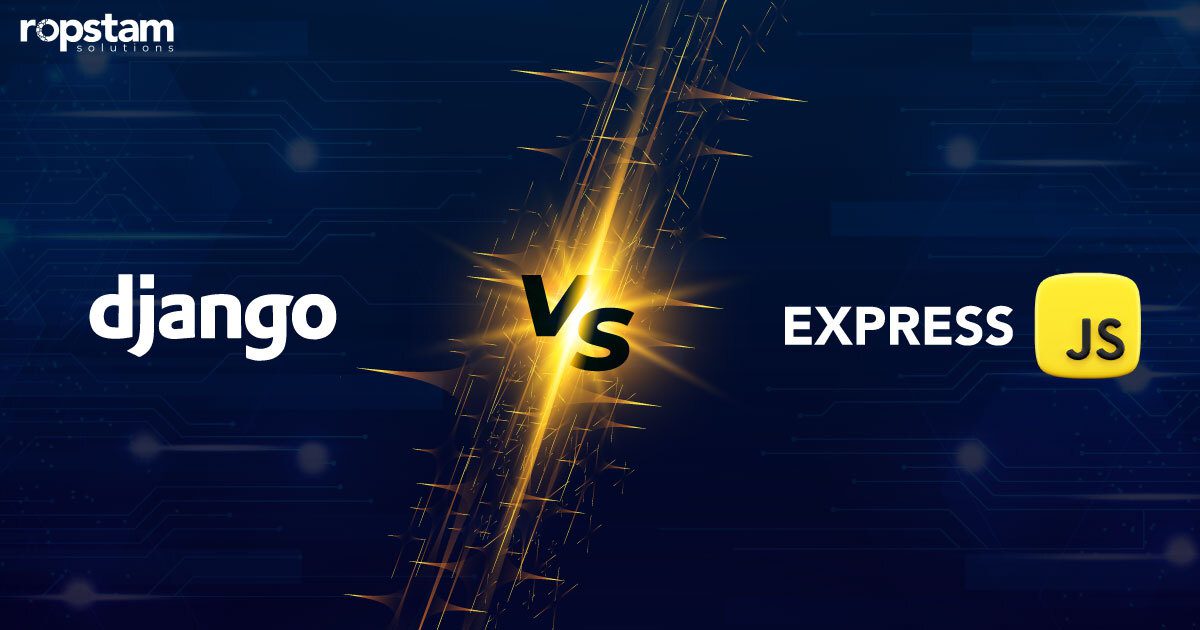Are you a developer and considering the development of a web application? In your deliberation between NestJS and ExpressJS, which framework is ideal to meet your project requirements?
Among the Node.js frameworks, ExpressJS and NestJS are the two most famous ones. Developers utilize both to create server-side applications. Node.js is an open-source, free-to-use platform for creating cross-platform server-side as well as networking applications with a wide range of utilizations. With Node.js, you can create both web and mobile apps.
This article will discuss the NestJS vs ExpressJS debate, encompassing their pros and cons in order to help you choose the right web frameworks for server-side application development.
NestJS vs. ExpressJS – The Comparison of Frameworks for Web App Developers
To further elaborate on the debate of these two renowned frameworks for backend development, we have crafted a comparison table that will elaborate the differences between Nestjs and Express js:
| Nest JS | Express JS |
| Provides a scalable architecture | Leaves the code structure up to the developer |
| It is an opinionated framework that promotes a modular architecture | Follows a minimalist approach |
| It has a default Jest-based testing environment | Unit testing requires the construction of manual codes |
| It is a newer framework with limited libraries available | It has a mature ecosystem and a wide range of libraries |
What is Nest JS?
NestJS is a framework based on TypeScript and JavaScript that is used for creating server-side applications by web developers. Since this framework is highly inspired by Angular, most of the Angular components, such as services, providers, and middleware, can also be found in Nest. Similarly, most of the functions supported by Express are also found in Nest.
NestJS Core Components
Let’s dig deeper into the core components of Nest that developers can use for programming and creating robust and scalable applications:
Modules: NestJS applications are organized into modules, which help in separating concerns and providing a clear structure. Modules encapsulate related functionality and can be independently developed and tested. Every NestJS application includes a fundamental module, referred to as the root module. This root module serves as the initial reference point for Nest to determine the architecture and connections within the application.
Controllers: Controllers handle incoming requests and define the routes for the application. They are responsible for processing requests, executing business logic, and returning responses to the client-side.
Providers: Providers in NestJS are responsible for injecting dependencies into other components. They can be services, repositories, or any other type of class that NestJS uses for dependency injection.
Middleware: Middleware functions can be used to intercept requests and modify their behavior. They can perform tasks such as authentication, data validation, or logging.
Pipes: Pipes allow for data transformation and validation. They can be used to sanitize and validate incoming data, ensuring its integrity before it reaches the controller.
Interceptors: Interceptors provide a way to modify the behavior of requests and responses globally. They can be used for tasks such as logging, error handling, or data transformation.
Exception Filters: Exception filters catch and handle exceptions that occur during the request processing pipeline. They provide a way to handle errors and return appropriate responses gracefully.
How to install NestJS?
Follow these steps to install NestJS on your system easily:
- NestJS requires Node.js to run. Visit the official Node.js website and download the latest LTS version suitable for your operating system. Follow the installation instructions provided by the Node.js installer.
- Nest CLI is a command-line interface that helps in creating and managing NestJS projects. Open your terminal or command prompt and run the following command to install the Nest CLI globally:
npm install -g @nestjs/cli
- Navigate to the desired directory where you want to create your NestJS project using the terminal or command prompt. Run the following command to create a new project:
nest new project-name
Features of NestJS
Here are the features of Nest that can help you in developing a wonderful web app:
Modular Architecture: NestJS promotes a modular and organized approach to building applications. It provides a built-in module system that allows developers to encapsulate related functionality into reusable and independent modules.
TypeScript Support: NestJS is built with TypeScript, a strongly typed superset of JavaScript. This enables developers to benefit from static typing, enhanced tooling, and improved code maintainability, making the development process more efficient and reliable.
Dependency Injection: This framework leverages dependency injection to manage the creation and injection of dependencies within the application. This helps in writing clean and testable code, improves code reusability, and facilitates the separation of concerns.
Middleware and Interceptors: It offers a middleware and interceptor system similar to frameworks like Express.js. Middleware functions can be used to modify incoming requests or outgoing responses, while interceptors allow for handling requests and responses at a global level, enabling cross-cutting concerns.
Scalability and Performance: By providing a solid foundation for building scalable and high-performance applications, Nest makes the developer’s job easier. It leverages the underlying power of frameworks like Express.js and Node.js while also offering features like async execution, caching, and support for microservices architecture, enabling developers to create efficient and scalable solutions.
Database Support: NestJS can easily support a lot of different databases including Apache Cassandra, PostgreSQL, MySQL, MongoDB, Redis, and others.
Pros of NestJS
- Excellent TypeScript support
- Built-in dependency injection
- Ability to handle large-scale applications
- Structured and organized code
Cons of NestJS
- Steep learning curve
- Strict architectural conventions
- Difficult initial setup
- Large-sized app bundles

What is ExpressJS?
ExpressJS is another popular Node.js web application framework for building web and mobile applications. By using Express in combination with Node, you can create single-page, multi-page, and even hybrid web applications like streaming and fintech apps.
It is comparatively easier to use and provides an array of easy-to-access features. Using this framework, developers have the luxury of rapidly building web apps without worrying about complex technologies.
ExpressJS Core Components
Following are the components of Express that you must know:
Routing: Express.js provides a flexible routing system that allows developers to define routes for handling different HTTP methods and URL patterns. This enables the application to respond to specific requests with the appropriate logic or data.
Middleware: It has a middleware architecture that allows developers to create custom middleware functions to handle requests and responses. Middleware functions can perform tasks such as authentication, logging, error handling, and more. They can be stacked together and executed in a specific order.
Request and Response Objects: This framework provides request and response objects, which encapsulate incoming HTTP requests and outgoing HTTP responses. These objects offer various methods and properties to manipulate and interact with the request and response data.
Templating Engines: Express.js supports various templating engines like EJS, Pug, and Handlebars. Templating engines allow developers to dynamically generate HTML markup by combining data with predefined templates.
Error Handling: Express.js provides built-in mechanisms for handling errors, such as middleware functions specifically designed to catch and process errors. Developers can define error-handling middleware to handle errors in a centralized manner and return appropriate error responses to clients.
Static File Serving: Express.js allows the serving of static files, such as images, CSS, and JavaScript files, directly from the file system. This simplifies the process of serving static assets required by web applications.
How to Install ExpressJS?
To install ExpressJS on your system, follow these steps:
- Open your command line interface and navigate to your project directory. Run the command “npm init -y” to create a new package.json file, which will store your project dependencies.
- Run the command npm install express to install the Express.js package. This will download and install the latest version of Express.js in your project directory.
- In your JavaScript file, require the Express.js module by adding the following line of code at the top: const express = require(‘express’);
- Declare an instance of the Express.js application by calling the express() function: const app = express();
- Define a route handler that will respond to incoming requests. For example, you can create a simple route that sends a “Hello, World!” message to the client:
app.get(‘/’, (req, res) => {
res.send(‘Hello, World!’);
});
- Now, add the following code at the end of your JavaScript file to start the server:
const port = 3000; // Choose an arbitrary port number
app.listen(port, () => {
console.log(`Server is running on port ${port}`);
});
- Save the changes in your JavaScript file and run the command node filename.js, replacing filename.js with the name of your file. This will start the Express.js server, and you can access it by visiting http://localhost:3000 in your web browser.
Features of ExpressJS
Consider the following features which choosing Express for your next web app project:
Minimal and unopinionated: Express.js is a lightweight and flexible web framework that provides just the fundamental features for building web applications. It allows developers to make decisions about how they structure their code and which additional libraries or tools they want to use.
Robust routing: Express.js provides a powerful routing system that allows developers to define routes for different HTTP methods (GET, POST, etc.) and URLs. This makes it easy to handle various types of requests and implement RESTful APIs.
Middleware support: Express.js has built-in support for middleware, which are functions that can modify the request and response objects, handle tasks like parsing request bodies or authenticating users, and enable additional functionality. The middleware system in Express.js allows for easy extension and customization of the application’s behavior, contributing to the battle of ExpressJS and NestJS.
Template engine integration: Express.js seamlessly integrates with various template engines like EJS, Handlebars, and Pug, enabling developers to dynamically generate HTML pages and render them with data from the server.
Easy integration with other libraries: Express.js plays well with other Node.js libraries and modules, making it easy to incorporate additional functionality into your application. It has a vast ecosystem of third-party middleware and extensions that can enhance the capabilities of your Express.js application.
Pros of ExpressJS
- Minimalistic framework
- Easy to learn
- Wide range of libraries available
- Excellent performance and stability
Cons of ExpressJS
- Lack of opinionated structure
- No built-in dependency injection
- Limited error handling
- Less built-in support
- Absence of MVC pattern
What is Node.js?
Node.js is an open-source JavaScript runtime environment that serves the primary purpose of building easy-to-use, scalable web applications. Written in C, C++, and JavaScript, Node.js’ runtime leverages the Google Chrome V8 engine and can run outside the browser.
Released in 2009, Node.js places each request in a queue, thus maintaining a limited pool of threads. By using fewer threads, this famed runtime environment leverages far fewer resources as well as memory, putting less burden and resulting in faster execution of tasks.
To summarize, creating a web application demands a lot of time and effort but with frameworks like NestJS and ExpressJS, the development cycle can be accelerated.
The Verdict
NestJS and ExpressJS are two categories of Node.js framework boasting their own sets of advantages and drawbacks. Ultimately, there is no winner in the debate of comparison of NestJS and ExpressJS, and the selection of a particular framework depends on the project’s scale and type.
Ropstam Solutions delivers top-notch back-end development services, creating custom solutions to meet your specific business objectives. Our expert team uses the latest technologies to build dynamic and scalable web applications. Contact us to embark on a journey toward enhancing your online presence and achieving digital success.















